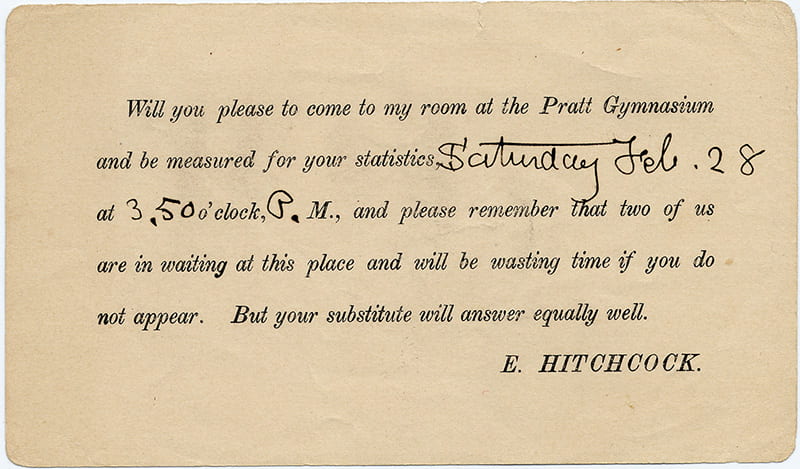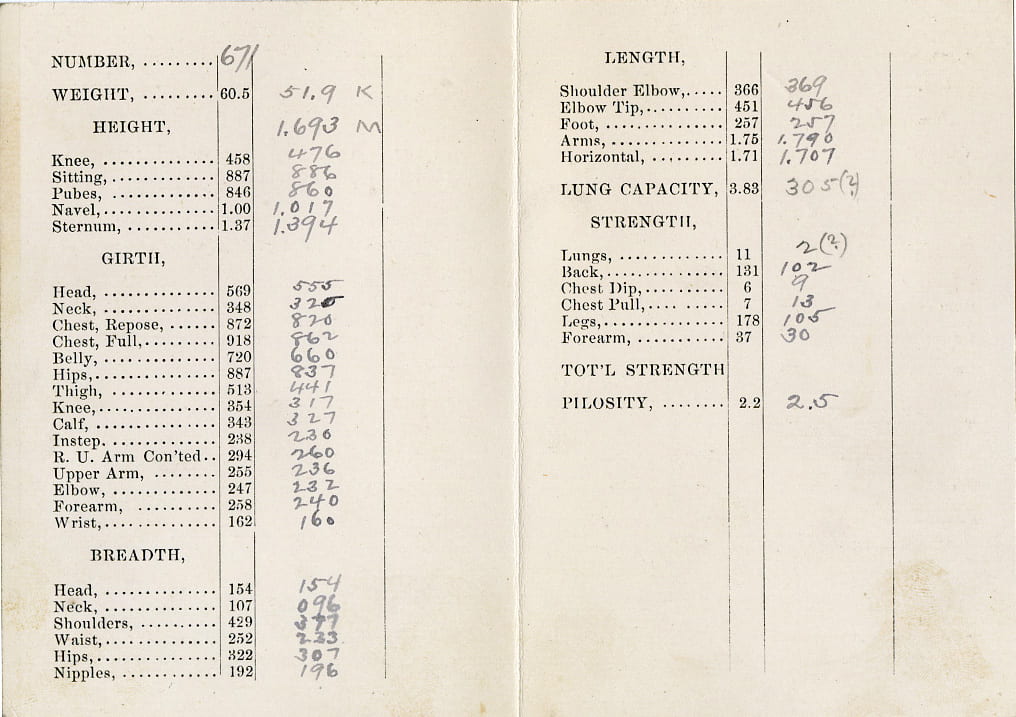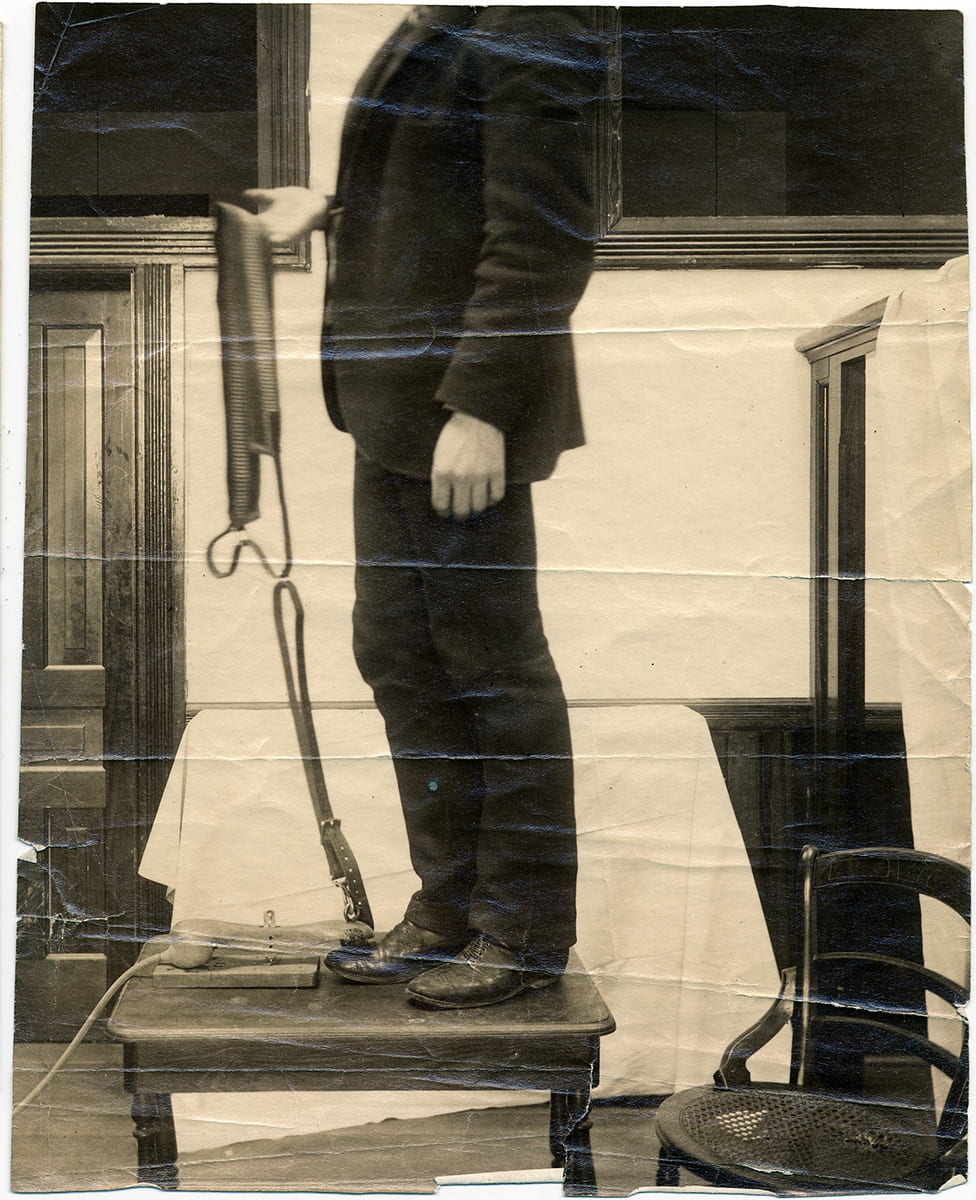A few weeks ago I wrote about our facial goniometer, an instrument that measures the precise angles of the human face, and wondered whether it had been acquired by Amherst’s college physician and professor of physical education and hygiene Edward “Doc” Hitchcock (AC 1849). This led me to further pondering about the interesting 19th century origins of anthropometry, the science of measurements and proportions of the human body.

In the fall of 1861, “Doc” Hitchcock, as Professor of Physical Education and Hygiene at Amherst, introduced his system of anthropometric measurements documenting the physical size and strength of every freshman for more than twenty years. These measurements became an American standard for comparative purposes and earned Hitchcock the reputation as a pioneer in this field.
The anthropometric protocol for students as instituted by Dr. Hitchcock involved over fifty different measurements in six different categories: heights, weights, lengths, breadths, girths and strengths. It required many kinds of specialized devices and an elaborate system of record-keeping to register them. The practice of measuring students was in fact so accepted and indeed so entrenched in the culture of Amherst in the 19th century (as well as at many other American colleges that adopted Hitchcock’s methods) that it was customary to include physical data even in an annual list of graduates:
 The table below lists not only the average measurements of the college population, but also the record highs in each category — as well as the name of the student holding that record:
The table below lists not only the average measurements of the college population, but also the record highs in each category — as well as the name of the student holding that record:

What was the purpose of all these measurements?

Hitchcock, in a paper entitled “The Need of Anthropometry” (1887), explained the rationale this way:
To learn what is the condition of all the young men as they come to us and how, and in what way can we help them to grow while connected with us, is the ultimate aim of the Anthropometric work of Amherst College. And the carrying out of this object involves the accurate observation of the physical characteristics of the students, and by a patient and long time process of comparing data, finally enabling the Department to declare to them a standard by which they may be judged.
“Doc” Hitchcock is widely credited as “the father of college physical education.” He took quite seriously Amherst president William A. Stearns’ emphasis on the goal of mens sana in corpore sano, a healthy mind in a healthy body, as the answer to the observable increase in morbidity among a sedentary class of college-educated Americans at that time in the country’s history. Many colleges and universities began to adopt European regimens of exercise for their students and built the first gymnasiums on their campuses. Amherst, under Stearns’ leadership, went one step farther in establishing the first department of Physical Education and Hygiene (and an endowed professorship to secure it).

The elaborate system of body measurements that Hitchcock introduced, then, was intended not (as one might queasily suspect) as a reference (veiled or not) to relative judgments on racial “purity” (eugenics being a hideous malformation of science that was to have its full bloom in the early decades of the following century). Rather, it indicated an attempt to educate the whole man — mind, body, soul — and encourage each one individually to be mindful of his body as a temple. I have little doubt that it was influenced by the Victorian ideal of “muscular Christianity,” a piety built on a foundation of fresh air, wholesome diet, sport and exercise.
Below, preserved in the college scrapbook of Shattuck Hartwell (AC 1888) is his personal booklet of anthropometric measurements, entered in pencil next to the printed average values for men in his height range. As can be seen from the numbers, Hartwell was probably told he should work harder in Amherst’s calisthenics classes to make up for many deficiencies!

Our Archives holds a wealth of material on anthropometry. The Edward (AC 1849) and Mary Judson Hitchcock Family Papers hold most of Doc Hitchcock’s writings on the subject and on physical education generally, and show too what a leading figure he was not only on the Amherst campus but nationwide in his field. The records of the Department of Physical Education and Hygiene contain annual reports, manuals, correspondence, articles by Hitchcock and other educators, and many tables of anthropometric data. Our Photographs Collection holds a few rare images showing anthropometry apparatus in use, as here:
The mustached man in the third photo above, by the way, can be identified as Leverett Bradley (AC 1873), a member of Amherst’s famed crew team that took the championship at the Springfield Regatta, July 1872. A formidable athlete, Bradley went on to become an Episcopal priest in Boston and Philadelphia. Muscular Christianity, indeed.







One thought on “Mens Sana in Corpore Sano: Anthropometry at Amherst College”